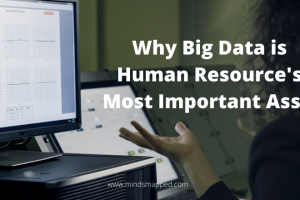
Vital Steps to Becoming a Data-Driven Business
The typical customer purchasing route is now more random than ever. He visits multiple websites, searches Google for promotional codes offer, check objective online sources for reviews of products and services that catch his fancy, before returning to an online vendor to make a purchase. Tracking and analyzing all these interactive patterns is a challenging task for a personnel profiler. However, it is a walkover for an intelligent algorithm. By capturing and analyzing all those online behavioral patterns, data analytics tools can collate in-depth user personas. The intensity of such a cluster of profiles is more far-reaching than the general demographics data. They track and analyze all the interactions a customer previously had with a company – clicks, reviews, products viewed, past purchases, and so on. These patterns are used to deliver personalized product recommendations based on the data captured and analyzed about customers.
This level of dominance is only found within the purview of businesses that are data-driven. Consequently, both emerging and established businesses are repositioning themselves to take advantage of the opportunities that data-driven businesses afford. Irrespective of the size of the company, there is some basic advice that applies to every size company when taking steps to make an organization more data-driven. Here are eight principles to bear in mind if an organization will become data-driven.
Pay Attention to Customer’s Digital Trail
The best companies have a focus on the customer. These companies use data to understand their customers, which, in turn, gives a better understanding of prospects to them. A key to using data efficiently is to know what you need to know about your clients and prospects. Search for the signal in the noise. Knowing customers’ attributes and the way they behave online can be a major deciding factor when it comes to generating revenue and profit. The considerations when an organization is working with big data revolve around the kind of questions the organization is trying to answer. When targeting prospects, what are the relevant features, and why are those features important? What industry do they work in? What is their company size? What is their job title or job function? Where is their geographic location? When prospects visit your website, what behavior indicates a willingness to make a purchase? Taking time with the pricing information? Downloading a particular white paper? Going through product datasheets? When analyzing customers, what features do your active customers have in common, and where can you find more of them? Which behavioral pattern indicates a likelihood of customers changing to a competitor, and what steps can you take to prevent their switching and retain them? To understand prospects, the key is digging into the buyer’s behavioral pattern. It’s about exploring and exploiting the buying pattern of your target audience. The first step is to find out what you need to measure and to do that you need to understand your objectives. Will your metric be based on generated leads? Or it will be based on sales or revenue?
Start Small when Dealing with Big Data
When integrating big data into your workflow, note little the triggers. The quantity of data, which is usually enormous, that the average company collects through its website can be overwhelming. For each site visitor, a company could collect data on that visitor’s demographics (based on his cookie), could identify whether she is a repeat visitor, could track his onsite behavior, and might analyze what drove him into the site, amongst other information that can be obtained.
The key is to determine what pieces of data about the customer are important to your company objectives. The deluge of information will distract your organization if you try to take on everything. Look for the tiny wins. Starting little makes sense for several reasons. First, it won’t tax your technology budget. It lets you construct the processes around data slowly and in a controlled fashion. And it allows having small wins using data that can earn you buy-in — and budget allocations — from the decision-makers to you. Implementing programs that are small but impactful can be deceptively simple. Sometimes some of the easiest steps are ignored. In a Harvard Business Review guest blog post on May 22, 2014, “Why Websites Still Can Not Predict Exactly What You Want,” Kaiser Fung, a statistician for Vimeo, said that personalization based on your previous website behavior is a simple step ignored by even the best companies. He writes that FreshDirect, an online grocer he uses, is taking simple steps to get personalization right: “If you search for a product you’ve purchased previously, FreshDirect arrange those products first, calling them’Your Fave.'” For instance, if you have purchased a six-pack of one-gallon container earlier. Now, you are looking for ‘water,’ Poland Spring appears at the peak of the list; if you search ‘Poland Spring,’ a six-pack of one-gallon containers appears. Personalized services like these foster efficient customer service.
Ensure Your Personnel are Resourceful
When considering your marketing staff, think less about raiding art schools and about setting up a booth at a Star Trek convention. Embracing big data means hiring data scientists, more mathematicians, and chief marketing technologists. Or put simply, hire people that are comfortable with spreadsheets and numbers, and are curious enough to want to comprehend the underlying details of what’s driving success. The marketing department needs creative people, but also, it demands analytical men and women who can provide insights so the team remains on track. Two hurdles identified to building a data-driven marketing team are getting access to the information, and then the next piece is finding the analytics people who will do something with the data.
However, getting skilled personnel in analytics is usually a herculean task. There’s a growing demand for their services. Google and Amazon can manage to attract and pay the experts on this stuff, but it is really hard to find and manage these groups of people. The average B2B company isn’t going to be able to cost-justify senior analytics personnel, because they hover around six figures. Flourishing organizations will have no problem coping with their cost but struggling ones will find it hard to afford them.
Familiarize Yourself with Technological Tools
Virtually every marketing leader has experienced the frustration of being at the mercy of the information technology section to get a sentence modified on the corporate site. But that’s changing quickly. Marketers are demanding that new technologies be available by their staffers rather than just IT. Technology is now an integral part of marketing. The consumer experience on a business website is as essential as the company tagline. Marketing must at the very least share control of the technology that is increasingly a part of its responsibilities. It’s important every marketing organization has and every marketing organization should have an analytics team that reports to the marketing organization.
Constantly Measure Your Processes
Big data provides insights into prospects and customers. It also tells marketers which of their programs are working or not. The enhanced measurement capabilities of marketing automation and the ease of A/B testing in digital environments make it possible for marketers to invest resources into the most effective programs.
Digital analytics and signals should be measured in real-time for adequate and effective response. Marketers will need to track their campaigns on a weekly or even hourly basis. Organizations need a dashboard mentality. Previously, analysis and measurement were limited and slow, now, all that has changed. Marketers had a difficult time measuring the impact of a print advertising campaign on revenue in the past. That irrevocably has been shifted by advertising technology systems’ growth. Today, organizations would like to check out the effectiveness. How many people opened the campaign? How much time did they engage with it? How many people responded? Three months later, how many businesses closed were achieved by the campaign? Today the effectiveness of campaigns can be measured. An emerging trend is the combination of devoted technology users and marketing automation systems who are equipped to find the required metrics for their organization to be able to carry out future successful campaigns.
Embrace Holistic Approach when working with Data
The daily emergence of new technologies has become overwhelming for conventional chief marketing officers (CMO), who are grappling with how to cope with their operations and usage. Hence, CMO is forced to outsourcing marketing automation to the millennials of digital natives. Unfortunately, millennials and digital natives do not know how to measure the effectiveness of marketing metrics in general. This creates a deadlock that takes its toll on the organization. Since technology is inextricably linked with marketing operations, strategy and software are unified, therefore for streamlined operations and results, the CMO must understand adept at both.
Have a Clear Objective but prepare for unforeseen Circumstances
Embracing information at most businesses can require a massive transformation. It may involve processes, new technologies, and a culture change, as well as the hiring of employees that are different. This transformation means big plans, and it may require outside consultants to pick the right technologies to help you map a plan, and make the right moves. But take care not to adhere. Big data is not about keeping pace; it is about building a large –and unique—advantage. Get your information in place so that you can measure and do things outside the box and do things that are wildly different, that will leapfrog you. There is not a copycat approach to marketing, Because then you’re only going to be as good as your peers not better.
Observe Effective Data Management
People think keeping data in a marketing database up-to-date would be a straight forward task. But it’s not—especially when you consider that one in five businesses changes a postal address every year. A report by NetProspex, a data vendor catering to marketing, called “The State of Marketing Data,” found that 88 percent of business databases were lacking very basic data, such as the prospects industry, company revenues, and the number of employees. An astonishing 64 percent of records did not include a phone number. This kind of information is critical for marketers and salespeople looking to start conversations with prospects. In the digital age, databases are essential, and they must be kept up-to-date. Findings have shown that quality database management has a marked impact on the success of marketing promotions. Clearly, data drives revenue for companies. To ensure that these databases are as productive as possible, marketers must maintain a good data management system.
The following steps are necessary to keep a proper data management system:
1. Make sure your data entry team is keying in data accurately in the first place. Make the data-entry team a priority.
2. Incentivize your sales team, call center squad, and other customer-facing employees to regularly request updated contact information and other data from the customers they encounter.
3. Use available software, such as Trillium, to streamline the process of cleansing, correcting, and appending e-mail and postal addresses.
4. Customers should be able to retrieve their data anytime, so they can update them regularly. Encourage customers to do this regularly by offering incentives.
5. Regularly contact customers, either via phone or e-mail, to update records. This approach is critical to the most important accounts.
Final Thoughts on becoming a data driven business
Big data doesn’t mean big spending. Advances in technology have made data accessible to every interested company in the world. About four decades ago, the cost of a gigabyte of storage was around $300,000. Now, it is sold for less than 2 cents. As a result, you don’t have to be a Google or an Amazon to derive the benefits of big data. All that is required is a modest investment in off-the-shelf marketing stack automation tools and intelligent algorithms.
Businesses that are data-driven have not only brought huge advantage into their organizations, but they are also repositioning their companies to be long-term leaders in a highly competitive world as they exploit the goldmine of the invaluable customer and prospect data in their e-mail lists, through website interactions, and via its e-commerce data capture.
Finally, my postulation is based on a modest proposition: the companies that most efficiently use big data to gain insight into their customers’ behavioral patterns and act on that insight will flourish. Make your business data-driven and customer-centric, and you will thrive.



